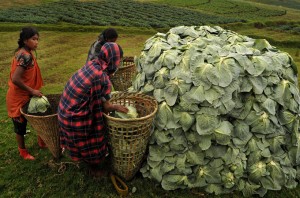
The Land Acquisition Act of 1894 was used by colonial rulers in India to forcibly remove peasants and tribal people from their ancestral land so that it could be used for commercial purposes. After independence, India instituted land reform laws to protect land for farmers. The World Bank’s structural adjustment program (SAP), however, reversed them in 1991 believing it would stimulate economic growth. While laws that protected farmers’ rights to land were reversed by the SAP, the colonial Land Acquisition Act was untouched. Now, according to Shiva, Indian policymakers favor the agendas of multinational companies over the needs of their country’s farmers. “[The] global economy, driven by speculative finance and limitless consumerism, wants the land for mining and for industry, for towns, highways, and biofuel plantations,” she says.
Shiva complains that under the guise of development for public purpose, farmers are forced to leave their land to make way for infrastructure projects. But along with the construction of highways and factories, portions of acquired land go to profit-making schemes that do not benefit the general public. Shiva gives an example of the Yamuna Expressway project in Bhatta Parsaul, Uttar Pradesh. “About 6,000 acres of land is being acquired by infrastructure company Jaiprakash Associates to build luxury townships and sports facilities—including a Formula 1 racetrack,” she says. “In total, the land of 1,225 villages is to be acquired for the 165 kilometer expressway.” Shiva cites the example of an 80 year-old named Parshuram who lost his land to the Yamuna Expressway. “You will never understand how it feels to become landless,” Parshuram said, according to Shiva.
“While land has been taken from farmers at 300 rupees (US$6) per square meter by the government using the Land Acquistion Act,” says Shiva, “it is sold by developers at 600,000 rupees (US$13,450) per square meter—a 200,000 percent increase in price.” Shiva claims that the practice of land grabbing for private profit is rampant in India today, and that it is often done violently. These grabs, according to Shiva, are not, “by any stretch of the imagination, for any public purpose.”
“Colonization was based on the violent takeover of land,” says Shiva. She equates the current climate in India to re-colonization through globalization, calling it a police state that uses sedition laws to vilify those who have protested land deals. “On April 18, in Jaitapur, Maharashtra, police opened fire on peaceful protesters demonstrating against the Nuclear Power Park proposed for a village adjacent to the small port town,” says Shiva. “One person died and at least eight were seriously injured. The Jaitapur nuclear plant will be the biggest in the world and is being built by French company AREVA. After the Fukushima disaster, the protest has intensified—as has the government’s stubbornness.”
“Today, a similar situation is brewing in Jagatsinghpur, Orissa where 20 battalions have been deployed to assist in the anti-constitutional land acquisition to protect the stake of India’s largest foreign direct investment—the POSCO Steel project. The government has set the target of destroying 40 betel farms a day to facilitate the land grab.”
The Indian constitution recognizes the rights of people, as well as village councils called panchayats, to democratically decide on issues of land in development, Shiva points out. “The government is disregarding these democratic decisions—as is evident from the POSCO project where three panchayats have refused to give up their land,” she says. “The use of violence and destruction of livelihoods that the current trend is reflecting is not only dangerous for the future of Indian democracy, but for the survival of the Indian nation state itself.”
Shiva says that the Indian government has confused its development priorities. Instead of encouraging the expansion of concrete jungles, she says, more needs to be done to ensure that the country’s land can continue to provide water and feed its people far into the future. “Creating multiple privatized super highways and expressways does not qualify as necessary infrastructure,” she says. “The real infrastructure India needs is the ecological infrastructure for food security and water security. Burying our fertile food-producing soils under concrete and factories is burying the country’s future.”
Do you know of any controversial development projects that are forcing farmers off of their land? Tell us about them in the comments!
Guest Post: By Matt Styslinger

Danielle Nierenberg, an expert on livestock and sustainability, currently serves as Project Director of State of World 2011 for the Worldwatch Institute, a Washington, DC-based environmental think tank. Her knowledge of factory farming and its global spread and sustainable agriculture has been cited widely in the New York Times Magazine, the International Herald Tribune, the Washington Post, and
other publications.
Danielle worked for two years as a Peace Corps volunteer in the Dominican Republic. She is currently traveling across Africa looking at innovations that are working to alleviate hunger and poverty and blogging everyday at Worldwatch Institute’s Nourishing the Planet. She has a regular column with the Mail & Guardian, the Kansas City Star, and the Huffington Post and her writing was been featured in newspapers across Africa including the Cape Town Argus, the Zambia Daily Mail, Coast Week (Kenya), and other African publications. She holds an M.S. in agriculture, food, and environment from Tufts University and a B.A. in environmental policy from Monmouth College.








